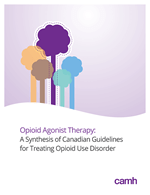Text adapted in 2023 from "Opioid Use and Opioid Use Disorders" in The Primary Care Addiction Toolkit. Revised version available online only.
When to taper opioids
The Centre for Effective Practice (2017, 2018d) describes protocols for monitoring and tapering opioids. It recommends evaluating the benefits and risks of continued opioid therapy at least every three months. Opioid tapering is indicated in the following situations:
- The opioid is not improving pain or functioning:
- The patient continues to report severe pain despite an adequate trial of two or three different opioids.
- The patient has not experienced an improvement in function or quality of life.
- Adverse effects outweigh the benefits of the opioid:
- overdose or warning signs (e.g., sedation, confusion, slurred speech)
- medical complications (e.g., sleep apnea, hyperalgesia, depressed mood)
- other adverse effects that are intolerable or impair functioning
- There are signs of opioid use disorder: The patient displays persistent drug-related aberrant behaviours despite reasonable adjustments to doses and dispensing intervals (e.g., diversion, changing route of opioid use, getting opioids from multiple sources).
Precautions for outpatient opioid tapering
- Pregnancy: Severe, acute opioid withdrawal has been associated with adverse pregnancy outcomes such as spontaneous abortion and premature labour.
- Unstable medical and psychiatric conditions that can be worsened by anxiety: Opioid withdrawal does not have serious medical consequences, but it can cause significant anxiety and insomnia.
- Addiction to opioids obtained from multiple prescribers or “the street”: Outpatient tapering is unlikely to succeed if the patient regularly obtains opioids from other sources. These patients should be referred for opioid agonist therapy (e.g., methadone, buprenorphine).
- Concurrent medication use: Avoid sedative-hypnotic drugs, especially benzodiazepines, during the taper because the potential for misuse is higher during tapering.
Opioid tapering protocol
Primary care providers can use the Opioid Tapering Template developed by the Centre for Effective Practice (2018d) to help pain patients reduce their opioid doses in a safe and effective way.
Before initiating the taper
- Explain to the patient why a taper is indicated and emphasize that the goal of tapering is to make the patient feel better – to reduce pain and improve mood and functioning.
- Ensure that the patient has clear expectations of tapering. Explain that withdrawal symptoms may occur and pain may get worse for a brief period after the dose is reduced, but that pain may improve as the patient stabilizes on the reduced dose.
- Determine the opioid formulation to be used, the dosing interval and the tapering schedule.
- Follow up with the patient frequently (e.g., every one to four weeks).
- Adjust the rate, intensity and duration of the taper according to the patient’s response (e.g. pain, function, withdrawal symptoms).
- Treat pain and function with non-opioids (see Management of Chronic Non Cancer Pain tool).
- Treat withdrawal symptoms prn.
- Taper to the lowest effective dose.
- Keep the daily dosing schedule the same for as long as possible (e.g., tid).
Determining a tapering schedule
- Establish a rate of taper based on the patient’s health, preference and comorbid conditions. The rate should be customized to meet the needs of each patient.
- Implement a slow taper. A taper of 510 per cent every two to four weeks is appropriate in most cases.
- Recognize that a more rapid taper over two to three weeks is likely to cause severe withdrawal symptoms (e.g., 10 per cent of the total daily dose every day) and is better suited to a medically supervised withdrawal setting.
- Use slower tapers for patients who are anxious about tapering, are psychologically dependent on opioids, have comorbid cardio-respiratory conditions or prefer this approach.
- Hold the dose when appropriate. The dose should be maintained or increased if the patient experiences severe withdrawal symptoms, significantly worse pain or mood, or reduced functioning during the taper.
Switching opioids for a taper
Other methods to taper or discontinue opioids include switching to another opioid, such as slow-release oral morphine, or switching to opioid agonist therapy, such as buprenorphine/naloxone, before initiating a taper.
To switch to morphine, follow these strategies outlined in the Opioid Manager developed by the Centre for Effective Practice (2017):
- Calculate equivalent dose of morphine (see conversion table in the Opioid Manager).
- Reduce dose by 2550 per cent of this equivalent dose (tolerance to one opioid is not fully transferred to another opioid).
- Adjust dose up or down as necessary to relieve withdrawal symptoms without inducing sedation.
To switch to buprenorphine/naloxone, review section B2 of Opioid Agonist Therapy: A Synthesis of Canadian Guidelines for Treating Opioid Use Disorder developed by the Centre for Addiction and Mental Health (2021). Consult an expert in prescribing buprenorphine-naloxone if you are not familiar with this formulation.
Monitoring during the taper
- Be prepared to provide frequent follow-up visits and supportive counselling (e.g., every one to four weeks).
- At each visit, ask about pain, functioning and general activity, withdrawal symptoms and possible benefits of the taper, such as reduced pain and improved mood, energy level and alertness. Tapering can result in a period of withdrawal-mediated pain, which should not be taken as evidence confirming opioid effectiveness for pain.
- Assess mood and anxiety in patients with a history of these mental health conditions (Patient Health Questionnaire [PHQ-9] and Generalized Anxiety Disorder Scale [GAD-7]).
- If the patient shows signs of an opioid use disorder during the taper, talk with them about being referred for opioid agonist treatment.
Completing the taper
- Tapers can usually be completed between two weeks and four months. Patients on chronic high-dose opioid therapy may require more time.
- Patients who are unable to complete the taper may be maintained at a lower dose if their mood and functioning improve and there is no indication of an opioid use disorder.
For more information on tapering and switching opioids and for opioid conversion tables, see the Opioid Manager developed by the Centre for Effective Practice (2017).


